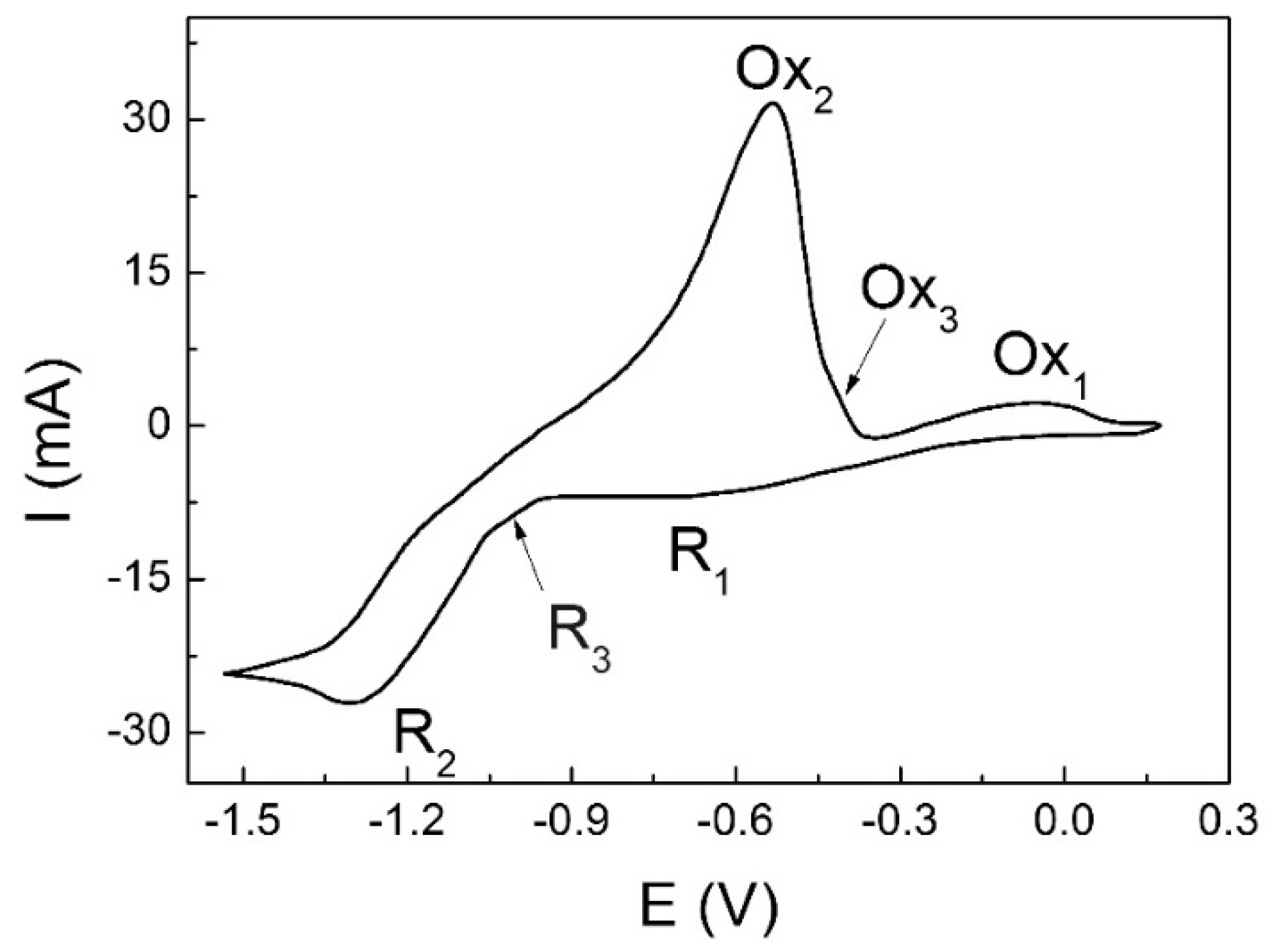Superconducting Niobium Coatings Deposited on Spherical Substrates in Molten Salts
Abstract
:1. Introduction
2. Materials and Methods
2.1. Chemicals and Preparation of Salts
2.2. Electrochemical Studies and Characterization
3. Results and Discussion
3.1. Choice of Substrate Material
3.2. Electrochemistry of Niobium Complexes in the NaCl–KCl–NaF–K2NbF7 Melt and the Effect of Oxide Ions
3.3. Electrodeposition of Niobium Coatings on Carbopyroceram Spheres, Cathode Construction
4. Conclusions
Author Contributions
Conflicts of Interest
References
- Lam, S.K.H.; Clem, J.R.; Yang, W. A nanoscale SQUID operating at high magnetic fields. Nanotechnology 2011, 22, 455501. [Google Scholar] [CrossRef] [PubMed]
- Kolosov, V.N.; Sheverev, A.A. Deposition of superconducting Nb3Sn and high-purity Nb coatings on the rotor of a cryogenic gyroscope. Inorg. Mater. 2012, 48, 176–181. [Google Scholar] [CrossRef]
- Kolosov, V.N.; Matychenko, E.S. Evaluation of high frequency superconductivity of Niobium coatings prepared by electrodeposition process in molten salts. In Refractory Metals in Molten Salts; Kluwer: Dordrecht, The Netherlands, 1998; pp. 231–238. [Google Scholar]
- Kolosov, V.N.; Novichkov, V.Y. Zero-current deposition of superconducting Nb3Sn coatings from molten salts. Inorg. Mater. 2003, 39, 485–491. [Google Scholar] [CrossRef]
- Pana, T.J.; Chena, Y.; Zhanga, B.; Hua, J.; Li, C. Corrosion behavior of niobium coated 304 stainless steel in acid solution. Appl. Surf. Sci. 2016, 369, 320–325. [Google Scholar] [CrossRef]
- Kumar, S.; Jyothirmayi, A.; Wasekar, N.; Joshi, S.V. Influence of annealing on mechanical and electrochemical properties of cold sprayed niobium coatings. Surf. Coat. Technol. 2016, 296, 124–135. [Google Scholar] [CrossRef]
- Liu, Q.; Zhang, L.; Cheng, L.; Liu, J.; Wang, Y. Low pressure chemical vapor deposition of niobium coating on silicon carbide. Appl. Surf. Sci. 2009, 255, 8611–8615. [Google Scholar] [CrossRef]
- Liu, Q.; Zhang, L.; Cheng, L. Low pressure chemical vapor deposition of niobium coatings on graphite. Vacuum 2010, 85, 332–337. [Google Scholar] [CrossRef]
- Dubrovskiy, A.R.; Okunev, M.A.; Makarova, O.V.; Kuznetsov, S.A. Corrosion resistance of the substrates for the cryogenic gyroscope and electrodeposition of the superconductive niobium coatings. J. Phys. Conf. Ser. 2017, 857, 012008. [Google Scholar] [CrossRef] [Green Version]
- Grinevich, V.V.; Kuznetsov, S.A.; Polyakov, E.G.; Stangrit, P.T. Electrolytic production of niobium with low oxygen content. Russ. Vysokochistye Veshchestva (High-Purity Subst.) 1988, 4, 87–89. [Google Scholar]
- Koch, C.C.; Scarbrough, J.O.; Kroeger, D.M. Effects of interstitial oxygen on the superconductivity of niobium. Phys. Rev. B 1974, 9, 888–897. [Google Scholar] [CrossRef]
- Kuznetsov, S.A. Electrochemistry of refractory metals in molten salts: Application for the creation of new and functional materials. Pure Appl. Chem. 2009, 81, 1423–1439. [Google Scholar] [CrossRef]
- Dubrovskiy, A.R.; Kuznetsov, S.A. Molten salts as a promising medium for the synthesis of highly active catalytic coatings. ECS Trans. 2012, 50, 677–683. [Google Scholar] [CrossRef]
- Kuznetsov, S.A.; Gaune-Escard, M. Redox electrochemistry of europium fluoride complexes in an equimolar NaCl-KCl melt. J. Nucl. Mater. 2011, 414, 126–131. [Google Scholar] [CrossRef]
- Kuznetsov, S.A.; Kazakova, O.S.; Makarova, O.V. Electrochemical behavior and electrorefining of cobalt in NaCl—KCl—K2TiF6 melt. Z. Naturforsch. 2009, 64, 485–491. [Google Scholar]
- Kuznetsov, S.A.; Grinevitch, V.V. Niobium interaction with its chloride, fluoride, and oxofluoride complexes in melts of alkali-metal chlorides. Russ. J. Appl. Chem. 1994, 67, 1249–1255. [Google Scholar]
- Kuznetsov, S.A.; Marenkova, E.A.; Kalinnikov, V.T. Micropassivation and complexation during electrodeposition of niobium coatings. Dokl. Chem. 2015, 463, 169–173. [Google Scholar] [CrossRef]
- Kuznetsov, S.A.; Kalinnikov, V.T. Metallization of glass-ceramic technological shells and oxide materials in molten salts. Glass Phys. Chem. 2008, 34, 575–581. [Google Scholar] [CrossRef]
- Chamelot, P.; Taxil, P.; Oquab, D. Niobium electrodeposition in molten fluorides using pulsed electrolysis. J. Electrochem. Soc. 2000, 147, 4131–4137. [Google Scholar] [CrossRef]
- Polyakov, E.G.; Polyakova, L.P.; Elizarova, I.R. Cathode processes in chloride-fluoride melts containing K2NbF7. Russ. J. Electrochem. 1995, 31, 502–509. [Google Scholar]
- Kuznetsov, S.А.; Polyakov, E.G.; Stangrit, P.T. Interdiffusion in bimetallic conductors of copper-niobium and copper alloy-niobium. Russ. J. Appl. Chem. 1997, 70, 1413–1416. [Google Scholar]
- ICDD (International Centre for Diffraction Data). Database. 2002. Available online: http://www.icdd.com/ (accessed on 16 May 2018).










| Specimen 1 | Treatment Time | Weight Change (%)/Corrosion Rate (mg·cm−2·h−1) | XRD Data | Specimen Surface Condition |
|---|---|---|---|---|
| C Al2O3/Mo 1 µm sphere | 10 min | −0.5 | Al2O3, Mo, NbO, Nb4O5, NbO2 | Peel-off of Mo coating |
| C Al2O3/Mo 0.75 µm sphere | 10 min | −0.16 | Al2O3, Mo, NbO, Nb4O5, NbO2 | Peel-off of Mo coating |
| Al2O3 bar | 50 min | −3.5/20 | Al2O3, NbO, Nb4O5, NbO2 | Coating + dendrites |
| CPC bar | 3 h | – | – | – |
| CPC bar | 12 h | +0.42 | NbC | Coating |
| Be cylinder | 10 min | −3.2/37.5 | Be, BeO | Substrate dissolution |
| B Be/Mo 1 µm sphere | 10 min | −1.05 | Be, BeO | Peel-off of Mo coating |
© 2018 by the authors. Licensee MDPI, Basel, Switzerland. This article is an open access article distributed under the terms and conditions of the Creative Commons Attribution (CC BY) license (http://creativecommons.org/licenses/by/4.0/).
Share and Cite
Dubrovskiy, A.; Okunev, M.; Makarova, O.; Kuznetsov, S. Superconducting Niobium Coatings Deposited on Spherical Substrates in Molten Salts. Coatings 2018, 8, 213. https://doi.org/10.3390/coatings8060213
Dubrovskiy A, Okunev M, Makarova O, Kuznetsov S. Superconducting Niobium Coatings Deposited on Spherical Substrates in Molten Salts. Coatings. 2018; 8(6):213. https://doi.org/10.3390/coatings8060213
Chicago/Turabian StyleDubrovskiy, Anton, Maksim Okunev, Olga Makarova, and Sergey Kuznetsov. 2018. "Superconducting Niobium Coatings Deposited on Spherical Substrates in Molten Salts" Coatings 8, no. 6: 213. https://doi.org/10.3390/coatings8060213





